Risk Management for Samsung Galaxy Note 7: Lessons Learned and Recommendations
VerifiedAdded on 2023/06/06
|13
|3473
|121
AI Summary
This report analyzes the risk management issues faced by Samsung due to its product Galaxy Note 7 and provides recommendations and lessons learned. It also discusses the reputation risk and risk treatment systems.
Contribute Materials
Your contribution can guide someone’s learning journey. Share your
documents today.

nnin ead i Mana ementRu g h : R sk g
i Mana ementR sk g
am n ala oteS su g G xy N 7
i Mana ementR sk g
am n ala oteS su g G xy N 7
Secure Best Marks with AI Grader
Need help grading? Try our AI Grader for instant feedback on your assignments.
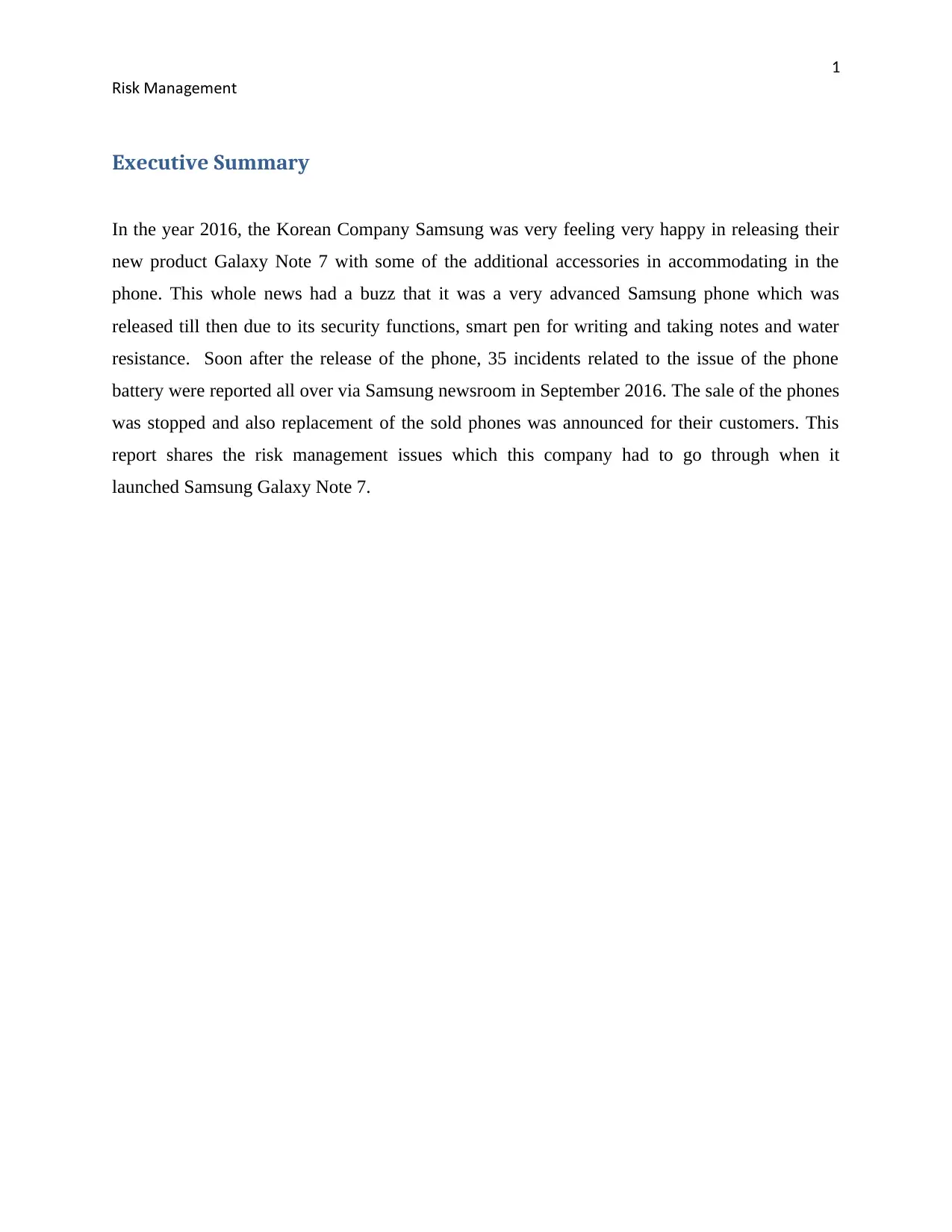
1
i Mana ementR sk g
Executive Summary
In the year 2016, the Korean Company Samsung was very feeling very happy in releasing their
new product Galaxy Note 7 with some of the additional accessories in accommodating in the
phone. This whole news had a buzz that it was a very advanced Samsung phone which was
released till then due to its security functions, smart pen for writing and taking notes and water
resistance. Soon after the release of the phone, 35 incidents related to the issue of the phone
battery were reported all over via Samsung newsroom in September 2016. The sale of the phones
was stopped and also replacement of the sold phones was announced for their customers. This
report shares the risk management issues which this company had to go through when it
launched Samsung Galaxy Note 7.
i Mana ementR sk g
Executive Summary
In the year 2016, the Korean Company Samsung was very feeling very happy in releasing their
new product Galaxy Note 7 with some of the additional accessories in accommodating in the
phone. This whole news had a buzz that it was a very advanced Samsung phone which was
released till then due to its security functions, smart pen for writing and taking notes and water
resistance. Soon after the release of the phone, 35 incidents related to the issue of the phone
battery were reported all over via Samsung newsroom in September 2016. The sale of the phones
was stopped and also replacement of the sold phones was announced for their customers. This
report shares the risk management issues which this company had to go through when it
launched Samsung Galaxy Note 7.
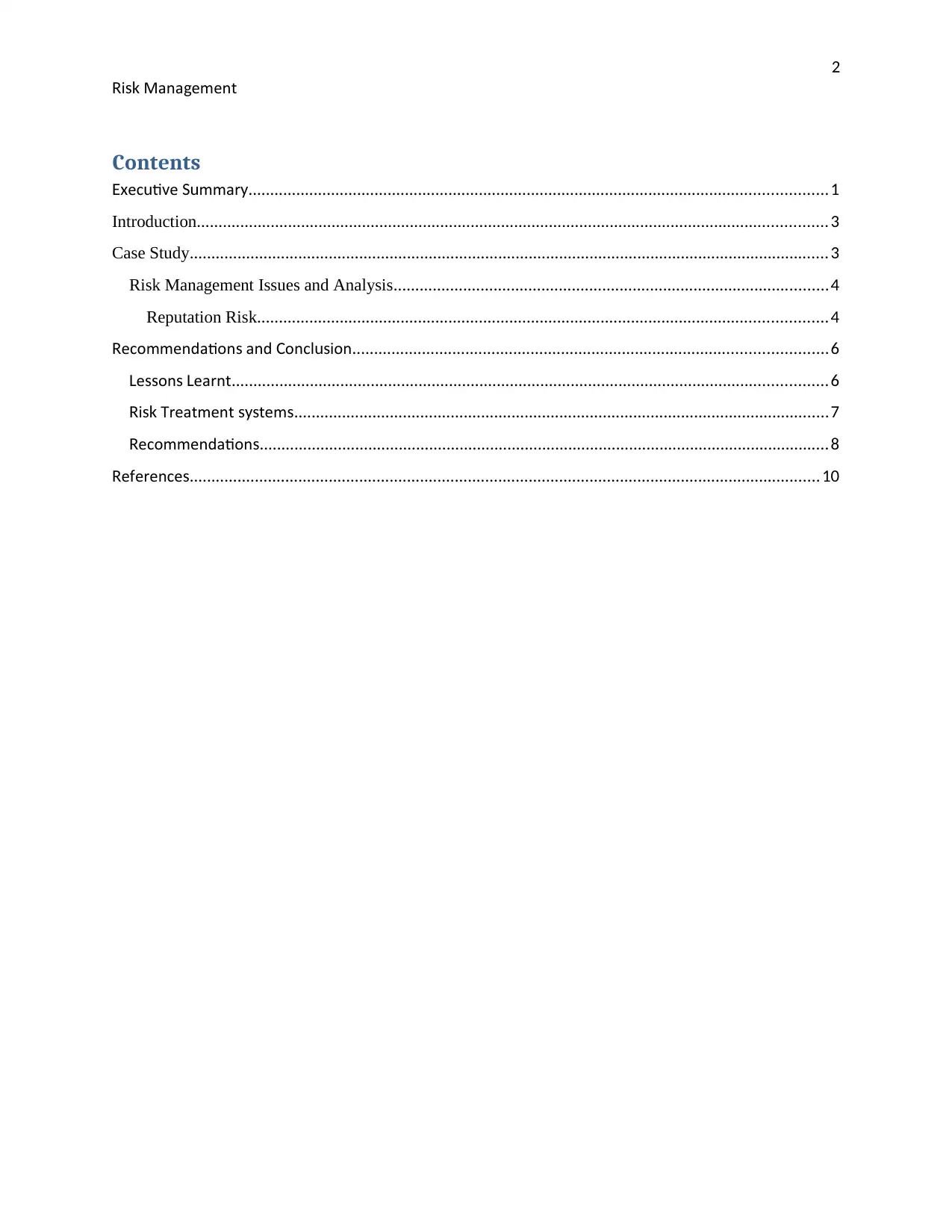
2
i Mana ementR sk g
Contents
ec ti e mmarEx u v Su y.....................................................................................................................................1
Introduction.................................................................................................................................................3
Case Study...................................................................................................................................................3
Risk Management Issues and Analysis....................................................................................................4
Reputation Risk...................................................................................................................................4
ecommendation and oncl ionR s C us .............................................................................................................6
e on earntL ss s L .........................................................................................................................................6
i Treatment temR sk sys s...........................................................................................................................7
ecommendationR s...................................................................................................................................8
e erenceR f s.................................................................................................................................................10
i Mana ementR sk g
Contents
ec ti e mmarEx u v Su y.....................................................................................................................................1
Introduction.................................................................................................................................................3
Case Study...................................................................................................................................................3
Risk Management Issues and Analysis....................................................................................................4
Reputation Risk...................................................................................................................................4
ecommendation and oncl ionR s C us .............................................................................................................6
e on earntL ss s L .........................................................................................................................................6
i Treatment temR sk sys s...........................................................................................................................7
ecommendationR s...................................................................................................................................8
e erenceR f s.................................................................................................................................................10
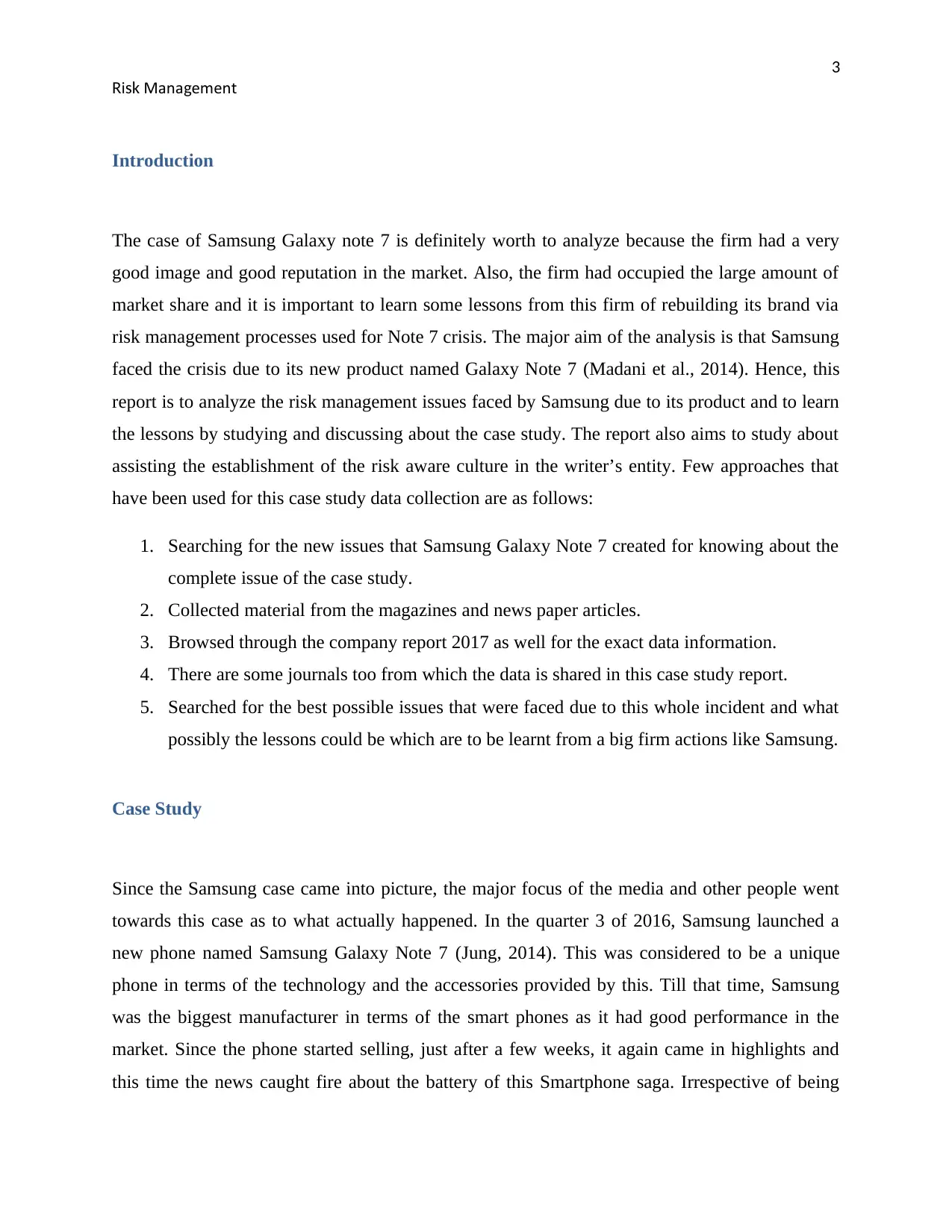
3
i Mana ementR sk g
Introduction
The case of Samsung Galaxy note 7 is definitely worth to analyze because the firm had a very
good image and good reputation in the market. Also, the firm had occupied the large amount of
market share and it is important to learn some lessons from this firm of rebuilding its brand via
risk management processes used for Note 7 crisis. The major aim of the analysis is that Samsung
faced the crisis due to its new product named Galaxy Note 7 (Madani et al., 2014). Hence, this
report is to analyze the risk management issues faced by Samsung due to its product and to learn
the lessons by studying and discussing about the case study. The report also aims to study about
assisting the establishment of the risk aware culture in the writer’s entity. Few approaches that
have been used for this case study data collection are as follows:
1. Searching for the new issues that Samsung Galaxy Note 7 created for knowing about the
complete issue of the case study.
2. Collected material from the magazines and news paper articles.
3. Browsed through the company report 2017 as well for the exact data information.
4. There are some journals too from which the data is shared in this case study report.
5. Searched for the best possible issues that were faced due to this whole incident and what
possibly the lessons could be which are to be learnt from a big firm actions like Samsung.
Case Study
Since the Samsung case came into picture, the major focus of the media and other people went
towards this case as to what actually happened. In the quarter 3 of 2016, Samsung launched a
new phone named Samsung Galaxy Note 7 (Jung, 2014). This was considered to be a unique
phone in terms of the technology and the accessories provided by this. Till that time, Samsung
was the biggest manufacturer in terms of the smart phones as it had good performance in the
market. Since the phone started selling, just after a few weeks, it again came in highlights and
this time the news caught fire about the battery of this Smartphone saga. Irrespective of being
i Mana ementR sk g
Introduction
The case of Samsung Galaxy note 7 is definitely worth to analyze because the firm had a very
good image and good reputation in the market. Also, the firm had occupied the large amount of
market share and it is important to learn some lessons from this firm of rebuilding its brand via
risk management processes used for Note 7 crisis. The major aim of the analysis is that Samsung
faced the crisis due to its new product named Galaxy Note 7 (Madani et al., 2014). Hence, this
report is to analyze the risk management issues faced by Samsung due to its product and to learn
the lessons by studying and discussing about the case study. The report also aims to study about
assisting the establishment of the risk aware culture in the writer’s entity. Few approaches that
have been used for this case study data collection are as follows:
1. Searching for the new issues that Samsung Galaxy Note 7 created for knowing about the
complete issue of the case study.
2. Collected material from the magazines and news paper articles.
3. Browsed through the company report 2017 as well for the exact data information.
4. There are some journals too from which the data is shared in this case study report.
5. Searched for the best possible issues that were faced due to this whole incident and what
possibly the lessons could be which are to be learnt from a big firm actions like Samsung.
Case Study
Since the Samsung case came into picture, the major focus of the media and other people went
towards this case as to what actually happened. In the quarter 3 of 2016, Samsung launched a
new phone named Samsung Galaxy Note 7 (Jung, 2014). This was considered to be a unique
phone in terms of the technology and the accessories provided by this. Till that time, Samsung
was the biggest manufacturer in terms of the smart phones as it had good performance in the
market. Since the phone started selling, just after a few weeks, it again came in highlights and
this time the news caught fire about the battery of this Smartphone saga. Irrespective of being
Secure Best Marks with AI Grader
Need help grading? Try our AI Grader for instant feedback on your assignments.
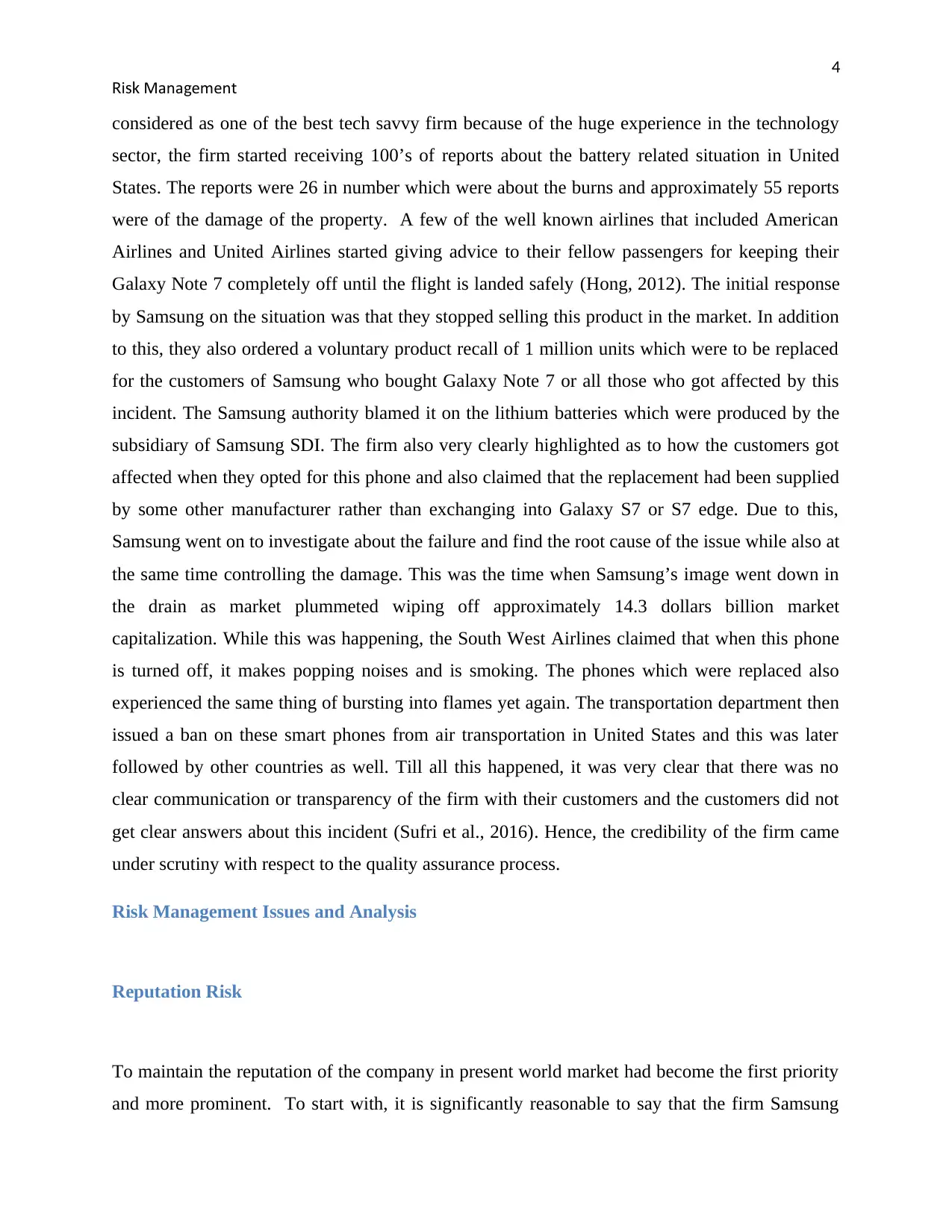
4
i Mana ementR sk g
considered as one of the best tech savvy firm because of the huge experience in the technology
sector, the firm started receiving 100’s of reports about the battery related situation in United
States. The reports were 26 in number which were about the burns and approximately 55 reports
were of the damage of the property. A few of the well known airlines that included American
Airlines and United Airlines started giving advice to their fellow passengers for keeping their
Galaxy Note 7 completely off until the flight is landed safely (Hong, 2012). The initial response
by Samsung on the situation was that they stopped selling this product in the market. In addition
to this, they also ordered a voluntary product recall of 1 million units which were to be replaced
for the customers of Samsung who bought Galaxy Note 7 or all those who got affected by this
incident. The Samsung authority blamed it on the lithium batteries which were produced by the
subsidiary of Samsung SDI. The firm also very clearly highlighted as to how the customers got
affected when they opted for this phone and also claimed that the replacement had been supplied
by some other manufacturer rather than exchanging into Galaxy S7 or S7 edge. Due to this,
Samsung went on to investigate about the failure and find the root cause of the issue while also at
the same time controlling the damage. This was the time when Samsung’s image went down in
the drain as market plummeted wiping off approximately 14.3 dollars billion market
capitalization. While this was happening, the South West Airlines claimed that when this phone
is turned off, it makes popping noises and is smoking. The phones which were replaced also
experienced the same thing of bursting into flames yet again. The transportation department then
issued a ban on these smart phones from air transportation in United States and this was later
followed by other countries as well. Till all this happened, it was very clear that there was no
clear communication or transparency of the firm with their customers and the customers did not
get clear answers about this incident (Sufri et al., 2016). Hence, the credibility of the firm came
under scrutiny with respect to the quality assurance process.
Risk Management Issues and Analysis
Reputation Risk
To maintain the reputation of the company in present world market had become the first priority
and more prominent. To start with, it is significantly reasonable to say that the firm Samsung
i Mana ementR sk g
considered as one of the best tech savvy firm because of the huge experience in the technology
sector, the firm started receiving 100’s of reports about the battery related situation in United
States. The reports were 26 in number which were about the burns and approximately 55 reports
were of the damage of the property. A few of the well known airlines that included American
Airlines and United Airlines started giving advice to their fellow passengers for keeping their
Galaxy Note 7 completely off until the flight is landed safely (Hong, 2012). The initial response
by Samsung on the situation was that they stopped selling this product in the market. In addition
to this, they also ordered a voluntary product recall of 1 million units which were to be replaced
for the customers of Samsung who bought Galaxy Note 7 or all those who got affected by this
incident. The Samsung authority blamed it on the lithium batteries which were produced by the
subsidiary of Samsung SDI. The firm also very clearly highlighted as to how the customers got
affected when they opted for this phone and also claimed that the replacement had been supplied
by some other manufacturer rather than exchanging into Galaxy S7 or S7 edge. Due to this,
Samsung went on to investigate about the failure and find the root cause of the issue while also at
the same time controlling the damage. This was the time when Samsung’s image went down in
the drain as market plummeted wiping off approximately 14.3 dollars billion market
capitalization. While this was happening, the South West Airlines claimed that when this phone
is turned off, it makes popping noises and is smoking. The phones which were replaced also
experienced the same thing of bursting into flames yet again. The transportation department then
issued a ban on these smart phones from air transportation in United States and this was later
followed by other countries as well. Till all this happened, it was very clear that there was no
clear communication or transparency of the firm with their customers and the customers did not
get clear answers about this incident (Sufri et al., 2016). Hence, the credibility of the firm came
under scrutiny with respect to the quality assurance process.
Risk Management Issues and Analysis
Reputation Risk
To maintain the reputation of the company in present world market had become the first priority
and more prominent. To start with, it is significantly reasonable to say that the firm Samsung
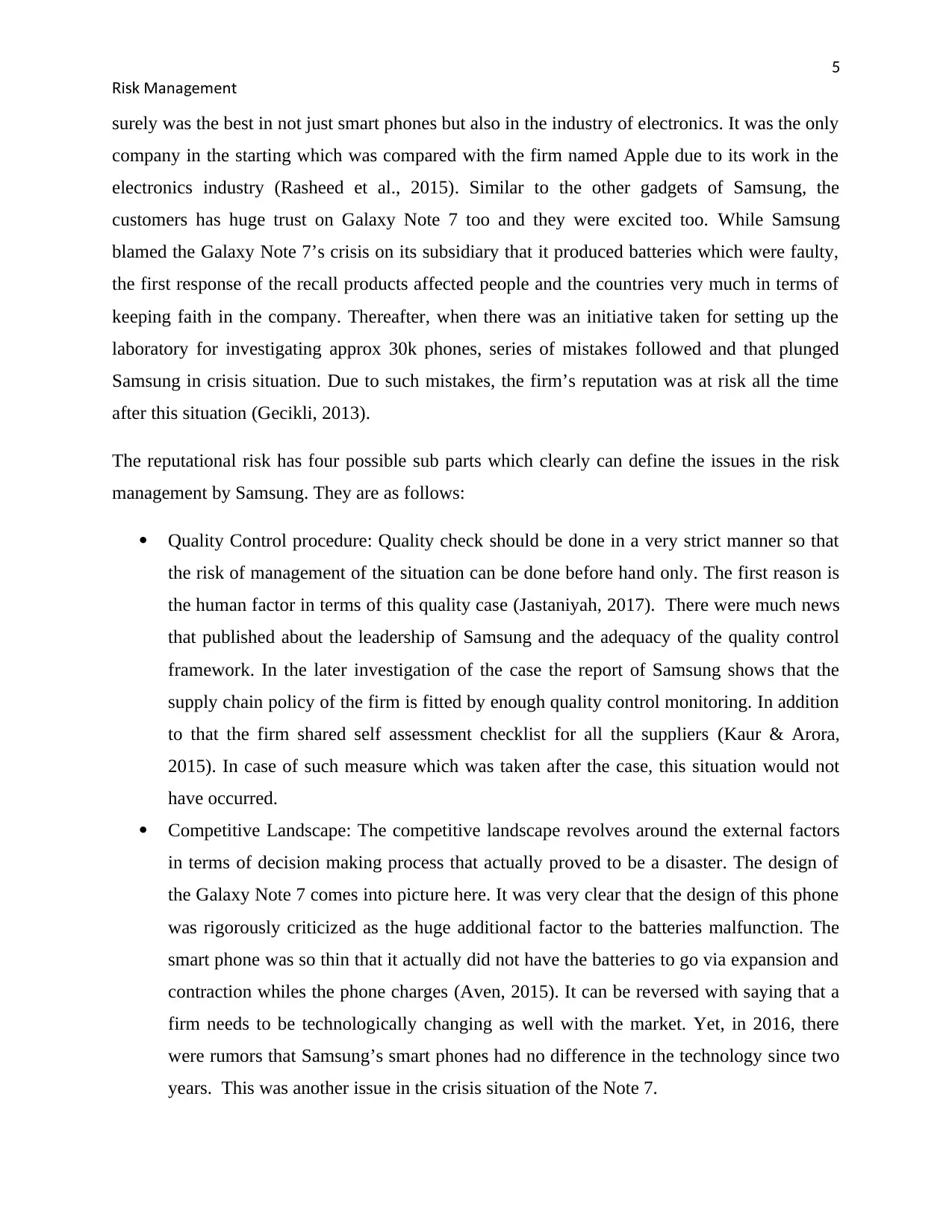
5
i Mana ementR sk g
surely was the best in not just smart phones but also in the industry of electronics. It was the only
company in the starting which was compared with the firm named Apple due to its work in the
electronics industry (Rasheed et al., 2015). Similar to the other gadgets of Samsung, the
customers has huge trust on Galaxy Note 7 too and they were excited too. While Samsung
blamed the Galaxy Note 7’s crisis on its subsidiary that it produced batteries which were faulty,
the first response of the recall products affected people and the countries very much in terms of
keeping faith in the company. Thereafter, when there was an initiative taken for setting up the
laboratory for investigating approx 30k phones, series of mistakes followed and that plunged
Samsung in crisis situation. Due to such mistakes, the firm’s reputation was at risk all the time
after this situation (Gecikli, 2013).
The reputational risk has four possible sub parts which clearly can define the issues in the risk
management by Samsung. They are as follows:
Quality Control procedure: Quality check should be done in a very strict manner so that
the risk of management of the situation can be done before hand only. The first reason is
the human factor in terms of this quality case (Jastaniyah, 2017). There were much news
that published about the leadership of Samsung and the adequacy of the quality control
framework. In the later investigation of the case the report of Samsung shows that the
supply chain policy of the firm is fitted by enough quality control monitoring. In addition
to that the firm shared self assessment checklist for all the suppliers (Kaur & Arora,
2015). In case of such measure which was taken after the case, this situation would not
have occurred.
Competitive Landscape: The competitive landscape revolves around the external factors
in terms of decision making process that actually proved to be a disaster. The design of
the Galaxy Note 7 comes into picture here. It was very clear that the design of this phone
was rigorously criticized as the huge additional factor to the batteries malfunction. The
smart phone was so thin that it actually did not have the batteries to go via expansion and
contraction whiles the phone charges (Aven, 2015). It can be reversed with saying that a
firm needs to be technologically changing as well with the market. Yet, in 2016, there
were rumors that Samsung’s smart phones had no difference in the technology since two
years. This was another issue in the crisis situation of the Note 7.
i Mana ementR sk g
surely was the best in not just smart phones but also in the industry of electronics. It was the only
company in the starting which was compared with the firm named Apple due to its work in the
electronics industry (Rasheed et al., 2015). Similar to the other gadgets of Samsung, the
customers has huge trust on Galaxy Note 7 too and they were excited too. While Samsung
blamed the Galaxy Note 7’s crisis on its subsidiary that it produced batteries which were faulty,
the first response of the recall products affected people and the countries very much in terms of
keeping faith in the company. Thereafter, when there was an initiative taken for setting up the
laboratory for investigating approx 30k phones, series of mistakes followed and that plunged
Samsung in crisis situation. Due to such mistakes, the firm’s reputation was at risk all the time
after this situation (Gecikli, 2013).
The reputational risk has four possible sub parts which clearly can define the issues in the risk
management by Samsung. They are as follows:
Quality Control procedure: Quality check should be done in a very strict manner so that
the risk of management of the situation can be done before hand only. The first reason is
the human factor in terms of this quality case (Jastaniyah, 2017). There were much news
that published about the leadership of Samsung and the adequacy of the quality control
framework. In the later investigation of the case the report of Samsung shows that the
supply chain policy of the firm is fitted by enough quality control monitoring. In addition
to that the firm shared self assessment checklist for all the suppliers (Kaur & Arora,
2015). In case of such measure which was taken after the case, this situation would not
have occurred.
Competitive Landscape: The competitive landscape revolves around the external factors
in terms of decision making process that actually proved to be a disaster. The design of
the Galaxy Note 7 comes into picture here. It was very clear that the design of this phone
was rigorously criticized as the huge additional factor to the batteries malfunction. The
smart phone was so thin that it actually did not have the batteries to go via expansion and
contraction whiles the phone charges (Aven, 2015). It can be reversed with saying that a
firm needs to be technologically changing as well with the market. Yet, in 2016, there
were rumors that Samsung’s smart phones had no difference in the technology since two
years. This was another issue in the crisis situation of the Note 7.
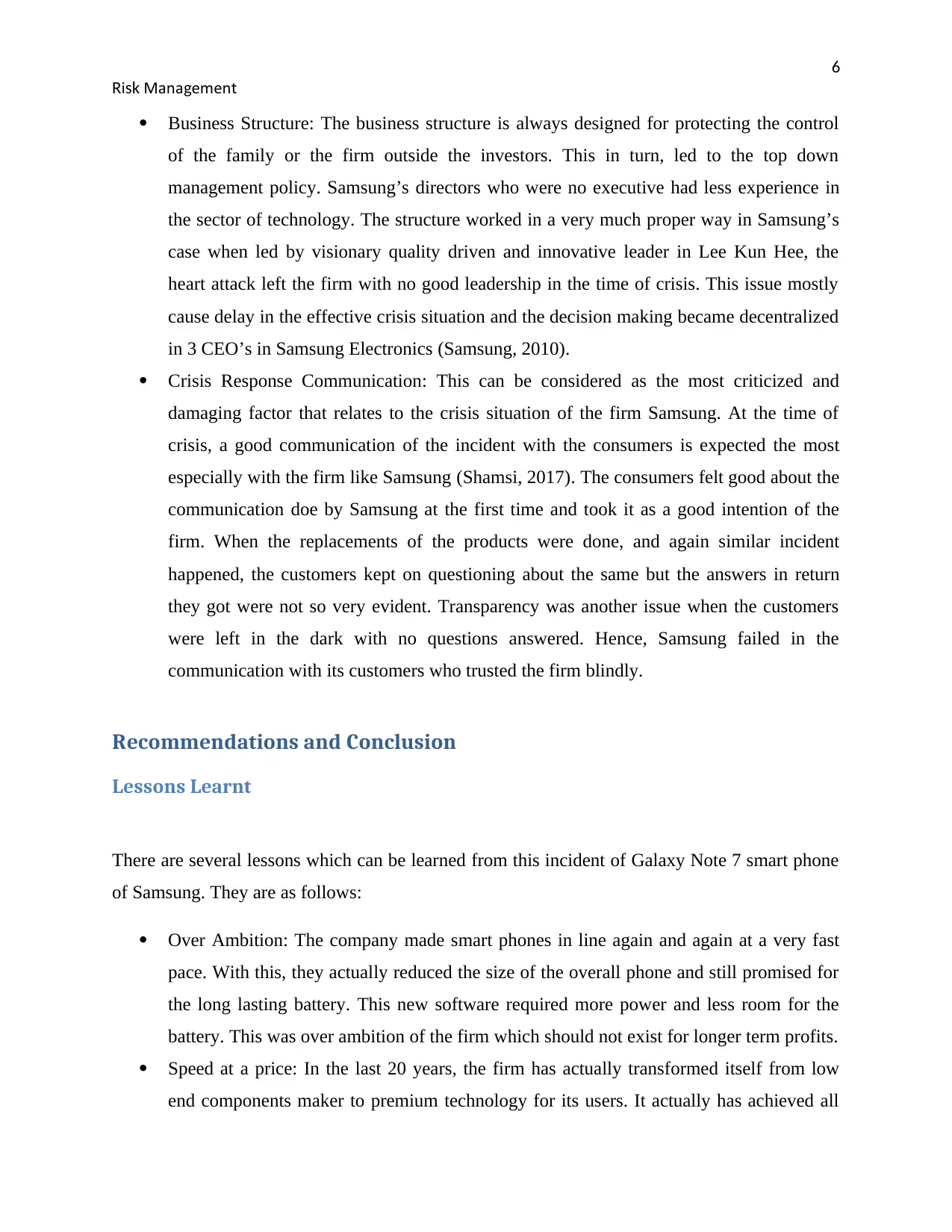
6
i Mana ementR sk g
Business Structure: The business structure is always designed for protecting the control
of the family or the firm outside the investors. This in turn, led to the top down
management policy. Samsung’s directors who were no executive had less experience in
the sector of technology. The structure worked in a very much proper way in Samsung’s
case when led by visionary quality driven and innovative leader in Lee Kun Hee, the
heart attack left the firm with no good leadership in the time of crisis. This issue mostly
cause delay in the effective crisis situation and the decision making became decentralized
in 3 CEO’s in Samsung Electronics (Samsung, 2010).
Crisis Response Communication: This can be considered as the most criticized and
damaging factor that relates to the crisis situation of the firm Samsung. At the time of
crisis, a good communication of the incident with the consumers is expected the most
especially with the firm like Samsung (Shamsi, 2017). The consumers felt good about the
communication doe by Samsung at the first time and took it as a good intention of the
firm. When the replacements of the products were done, and again similar incident
happened, the customers kept on questioning about the same but the answers in return
they got were not so very evident. Transparency was another issue when the customers
were left in the dark with no questions answered. Hence, Samsung failed in the
communication with its customers who trusted the firm blindly.
Recommendations and Conclusion
Lessons Learnt
There are several lessons which can be learned from this incident of Galaxy Note 7 smart phone
of Samsung. They are as follows:
Over Ambition: The company made smart phones in line again and again at a very fast
pace. With this, they actually reduced the size of the overall phone and still promised for
the long lasting battery. This new software required more power and less room for the
battery. This was over ambition of the firm which should not exist for longer term profits.
Speed at a price: In the last 20 years, the firm has actually transformed itself from low
end components maker to premium technology for its users. It actually has achieved all
i Mana ementR sk g
Business Structure: The business structure is always designed for protecting the control
of the family or the firm outside the investors. This in turn, led to the top down
management policy. Samsung’s directors who were no executive had less experience in
the sector of technology. The structure worked in a very much proper way in Samsung’s
case when led by visionary quality driven and innovative leader in Lee Kun Hee, the
heart attack left the firm with no good leadership in the time of crisis. This issue mostly
cause delay in the effective crisis situation and the decision making became decentralized
in 3 CEO’s in Samsung Electronics (Samsung, 2010).
Crisis Response Communication: This can be considered as the most criticized and
damaging factor that relates to the crisis situation of the firm Samsung. At the time of
crisis, a good communication of the incident with the consumers is expected the most
especially with the firm like Samsung (Shamsi, 2017). The consumers felt good about the
communication doe by Samsung at the first time and took it as a good intention of the
firm. When the replacements of the products were done, and again similar incident
happened, the customers kept on questioning about the same but the answers in return
they got were not so very evident. Transparency was another issue when the customers
were left in the dark with no questions answered. Hence, Samsung failed in the
communication with its customers who trusted the firm blindly.
Recommendations and Conclusion
Lessons Learnt
There are several lessons which can be learned from this incident of Galaxy Note 7 smart phone
of Samsung. They are as follows:
Over Ambition: The company made smart phones in line again and again at a very fast
pace. With this, they actually reduced the size of the overall phone and still promised for
the long lasting battery. This new software required more power and less room for the
battery. This was over ambition of the firm which should not exist for longer term profits.
Speed at a price: In the last 20 years, the firm has actually transformed itself from low
end components maker to premium technology for its users. It actually has achieved all
Paraphrase This Document
Need a fresh take? Get an instant paraphrase of this document with our AI Paraphraser
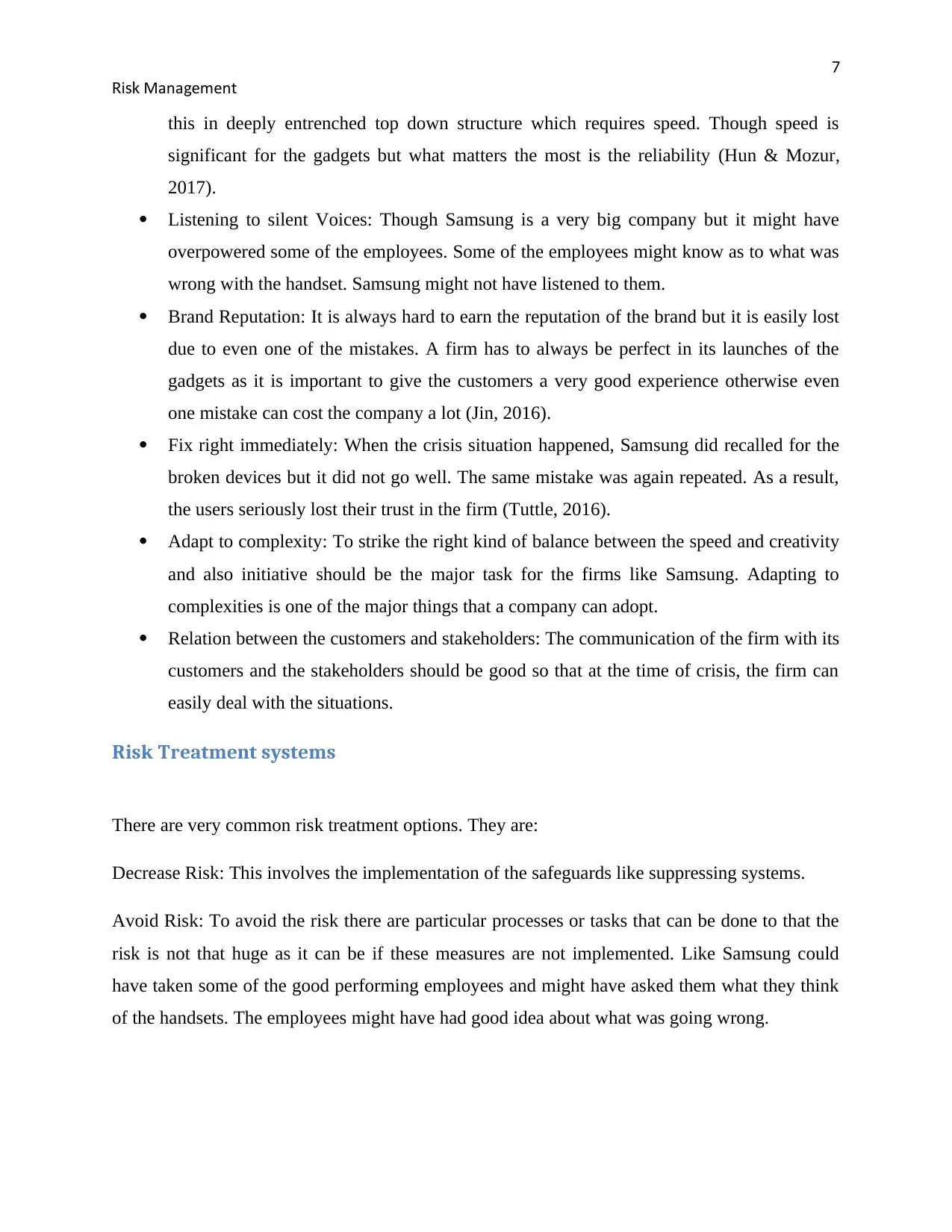
7
i Mana ementR sk g
this in deeply entrenched top down structure which requires speed. Though speed is
significant for the gadgets but what matters the most is the reliability (Hun & Mozur,
2017).
Listening to silent Voices: Though Samsung is a very big company but it might have
overpowered some of the employees. Some of the employees might know as to what was
wrong with the handset. Samsung might not have listened to them.
Brand Reputation: It is always hard to earn the reputation of the brand but it is easily lost
due to even one of the mistakes. A firm has to always be perfect in its launches of the
gadgets as it is important to give the customers a very good experience otherwise even
one mistake can cost the company a lot (Jin, 2016).
Fix right immediately: When the crisis situation happened, Samsung did recalled for the
broken devices but it did not go well. The same mistake was again repeated. As a result,
the users seriously lost their trust in the firm (Tuttle, 2016).
Adapt to complexity: To strike the right kind of balance between the speed and creativity
and also initiative should be the major task for the firms like Samsung. Adapting to
complexities is one of the major things that a company can adopt.
Relation between the customers and stakeholders: The communication of the firm with its
customers and the stakeholders should be good so that at the time of crisis, the firm can
easily deal with the situations.
Risk Treatment systems
There are very common risk treatment options. They are:
Decrease Risk: This involves the implementation of the safeguards like suppressing systems.
Avoid Risk: To avoid the risk there are particular processes or tasks that can be done to that the
risk is not that huge as it can be if these measures are not implemented. Like Samsung could
have taken some of the good performing employees and might have asked them what they think
of the handsets. The employees might have had good idea about what was going wrong.
i Mana ementR sk g
this in deeply entrenched top down structure which requires speed. Though speed is
significant for the gadgets but what matters the most is the reliability (Hun & Mozur,
2017).
Listening to silent Voices: Though Samsung is a very big company but it might have
overpowered some of the employees. Some of the employees might know as to what was
wrong with the handset. Samsung might not have listened to them.
Brand Reputation: It is always hard to earn the reputation of the brand but it is easily lost
due to even one of the mistakes. A firm has to always be perfect in its launches of the
gadgets as it is important to give the customers a very good experience otherwise even
one mistake can cost the company a lot (Jin, 2016).
Fix right immediately: When the crisis situation happened, Samsung did recalled for the
broken devices but it did not go well. The same mistake was again repeated. As a result,
the users seriously lost their trust in the firm (Tuttle, 2016).
Adapt to complexity: To strike the right kind of balance between the speed and creativity
and also initiative should be the major task for the firms like Samsung. Adapting to
complexities is one of the major things that a company can adopt.
Relation between the customers and stakeholders: The communication of the firm with its
customers and the stakeholders should be good so that at the time of crisis, the firm can
easily deal with the situations.
Risk Treatment systems
There are very common risk treatment options. They are:
Decrease Risk: This involves the implementation of the safeguards like suppressing systems.
Avoid Risk: To avoid the risk there are particular processes or tasks that can be done to that the
risk is not that huge as it can be if these measures are not implemented. Like Samsung could
have taken some of the good performing employees and might have asked them what they think
of the handsets. The employees might have had good idea about what was going wrong.
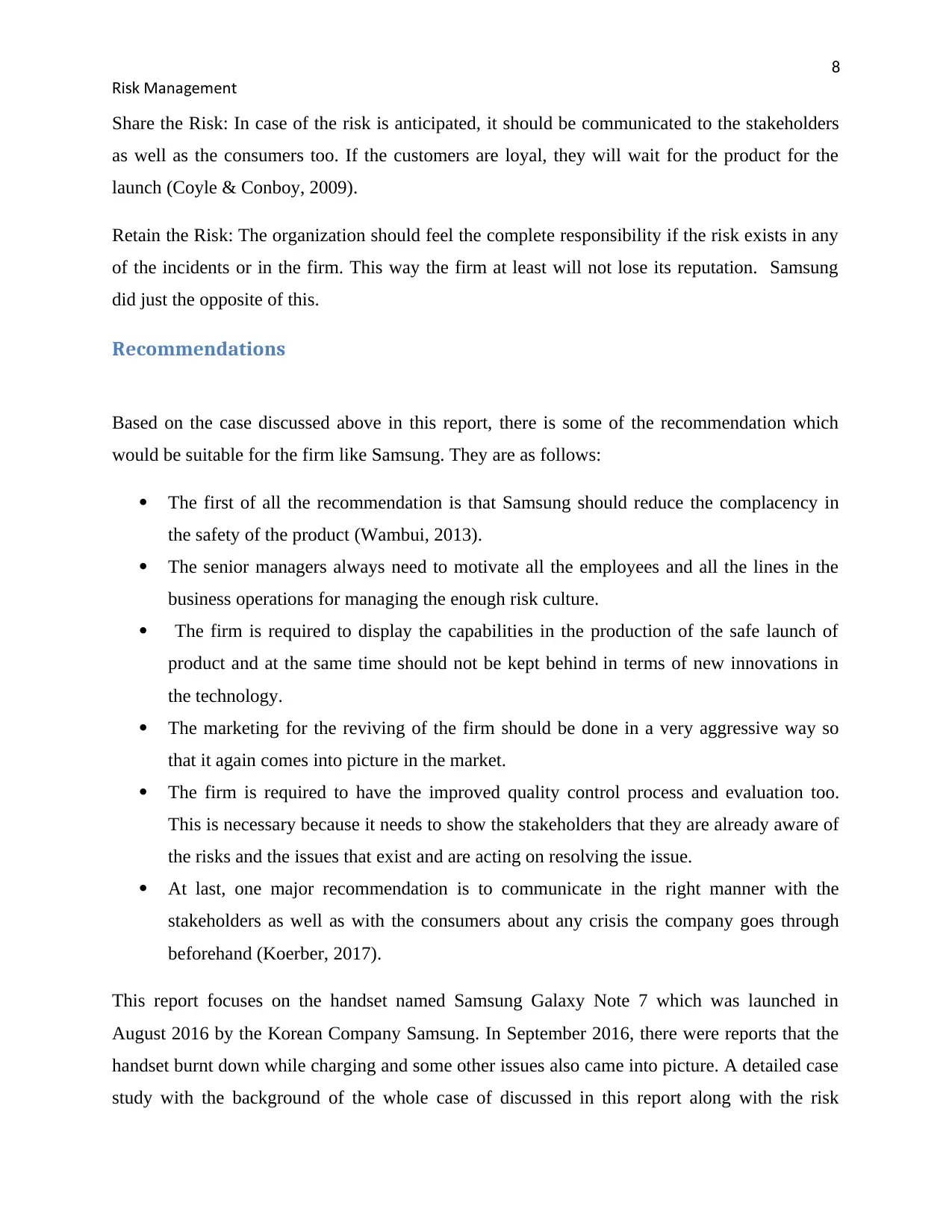
8
i Mana ementR sk g
Share the Risk: In case of the risk is anticipated, it should be communicated to the stakeholders
as well as the consumers too. If the customers are loyal, they will wait for the product for the
launch (Coyle & Conboy, 2009).
Retain the Risk: The organization should feel the complete responsibility if the risk exists in any
of the incidents or in the firm. This way the firm at least will not lose its reputation. Samsung
did just the opposite of this.
Recommendations
Based on the case discussed above in this report, there is some of the recommendation which
would be suitable for the firm like Samsung. They are as follows:
The first of all the recommendation is that Samsung should reduce the complacency in
the safety of the product (Wambui, 2013).
The senior managers always need to motivate all the employees and all the lines in the
business operations for managing the enough risk culture.
The firm is required to display the capabilities in the production of the safe launch of
product and at the same time should not be kept behind in terms of new innovations in
the technology.
The marketing for the reviving of the firm should be done in a very aggressive way so
that it again comes into picture in the market.
The firm is required to have the improved quality control process and evaluation too.
This is necessary because it needs to show the stakeholders that they are already aware of
the risks and the issues that exist and are acting on resolving the issue.
At last, one major recommendation is to communicate in the right manner with the
stakeholders as well as with the consumers about any crisis the company goes through
beforehand (Koerber, 2017).
This report focuses on the handset named Samsung Galaxy Note 7 which was launched in
August 2016 by the Korean Company Samsung. In September 2016, there were reports that the
handset burnt down while charging and some other issues also came into picture. A detailed case
study with the background of the whole case of discussed in this report along with the risk
i Mana ementR sk g
Share the Risk: In case of the risk is anticipated, it should be communicated to the stakeholders
as well as the consumers too. If the customers are loyal, they will wait for the product for the
launch (Coyle & Conboy, 2009).
Retain the Risk: The organization should feel the complete responsibility if the risk exists in any
of the incidents or in the firm. This way the firm at least will not lose its reputation. Samsung
did just the opposite of this.
Recommendations
Based on the case discussed above in this report, there is some of the recommendation which
would be suitable for the firm like Samsung. They are as follows:
The first of all the recommendation is that Samsung should reduce the complacency in
the safety of the product (Wambui, 2013).
The senior managers always need to motivate all the employees and all the lines in the
business operations for managing the enough risk culture.
The firm is required to display the capabilities in the production of the safe launch of
product and at the same time should not be kept behind in terms of new innovations in
the technology.
The marketing for the reviving of the firm should be done in a very aggressive way so
that it again comes into picture in the market.
The firm is required to have the improved quality control process and evaluation too.
This is necessary because it needs to show the stakeholders that they are already aware of
the risks and the issues that exist and are acting on resolving the issue.
At last, one major recommendation is to communicate in the right manner with the
stakeholders as well as with the consumers about any crisis the company goes through
beforehand (Koerber, 2017).
This report focuses on the handset named Samsung Galaxy Note 7 which was launched in
August 2016 by the Korean Company Samsung. In September 2016, there were reports that the
handset burnt down while charging and some other issues also came into picture. A detailed case
study with the background of the whole case of discussed in this report along with the risk
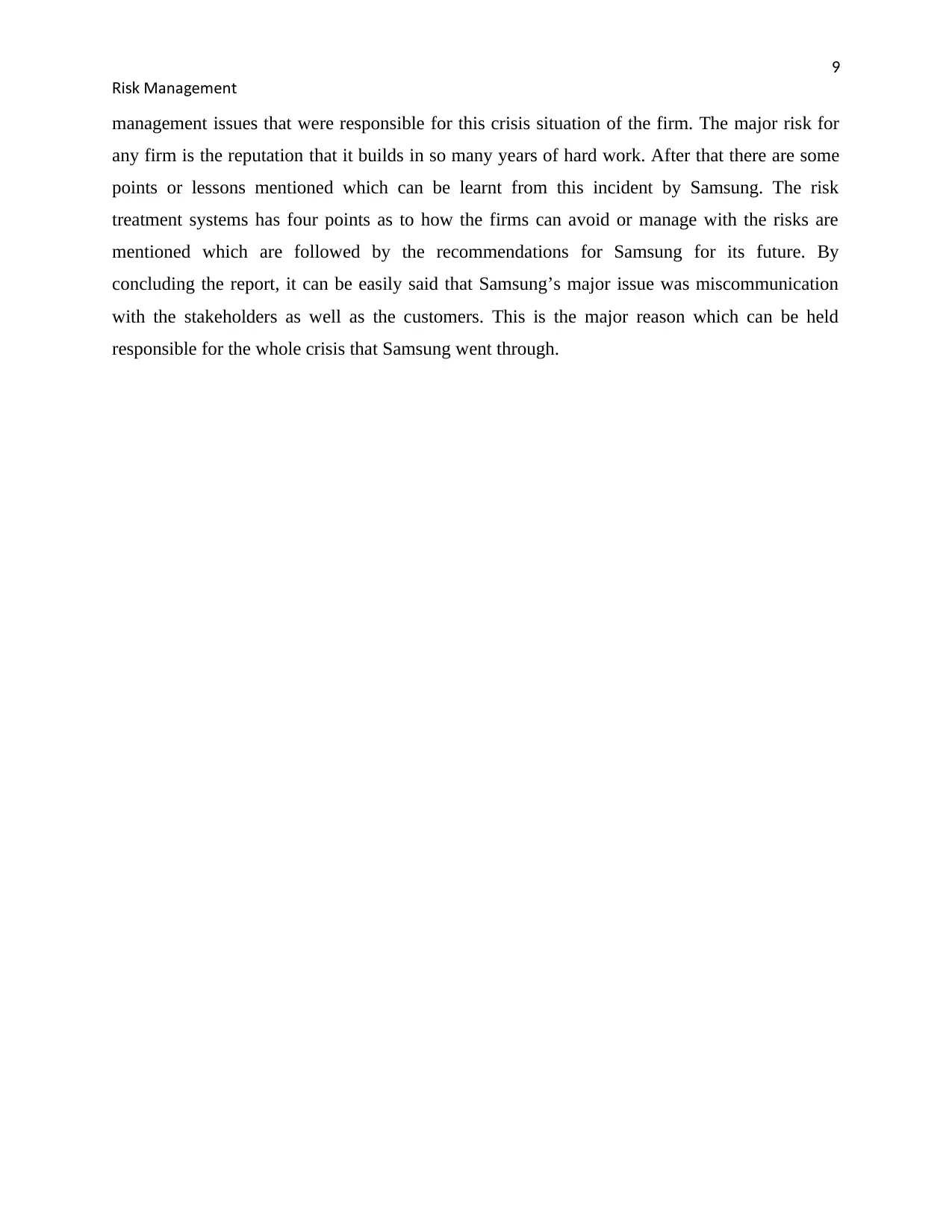
9
i Mana ementR sk g
management issues that were responsible for this crisis situation of the firm. The major risk for
any firm is the reputation that it builds in so many years of hard work. After that there are some
points or lessons mentioned which can be learnt from this incident by Samsung. The risk
treatment systems has four points as to how the firms can avoid or manage with the risks are
mentioned which are followed by the recommendations for Samsung for its future. By
concluding the report, it can be easily said that Samsung’s major issue was miscommunication
with the stakeholders as well as the customers. This is the major reason which can be held
responsible for the whole crisis that Samsung went through.
i Mana ementR sk g
management issues that were responsible for this crisis situation of the firm. The major risk for
any firm is the reputation that it builds in so many years of hard work. After that there are some
points or lessons mentioned which can be learnt from this incident by Samsung. The risk
treatment systems has four points as to how the firms can avoid or manage with the risks are
mentioned which are followed by the recommendations for Samsung for its future. By
concluding the report, it can be easily said that Samsung’s major issue was miscommunication
with the stakeholders as well as the customers. This is the major reason which can be held
responsible for the whole crisis that Samsung went through.
Secure Best Marks with AI Grader
Need help grading? Try our AI Grader for instant feedback on your assignments.
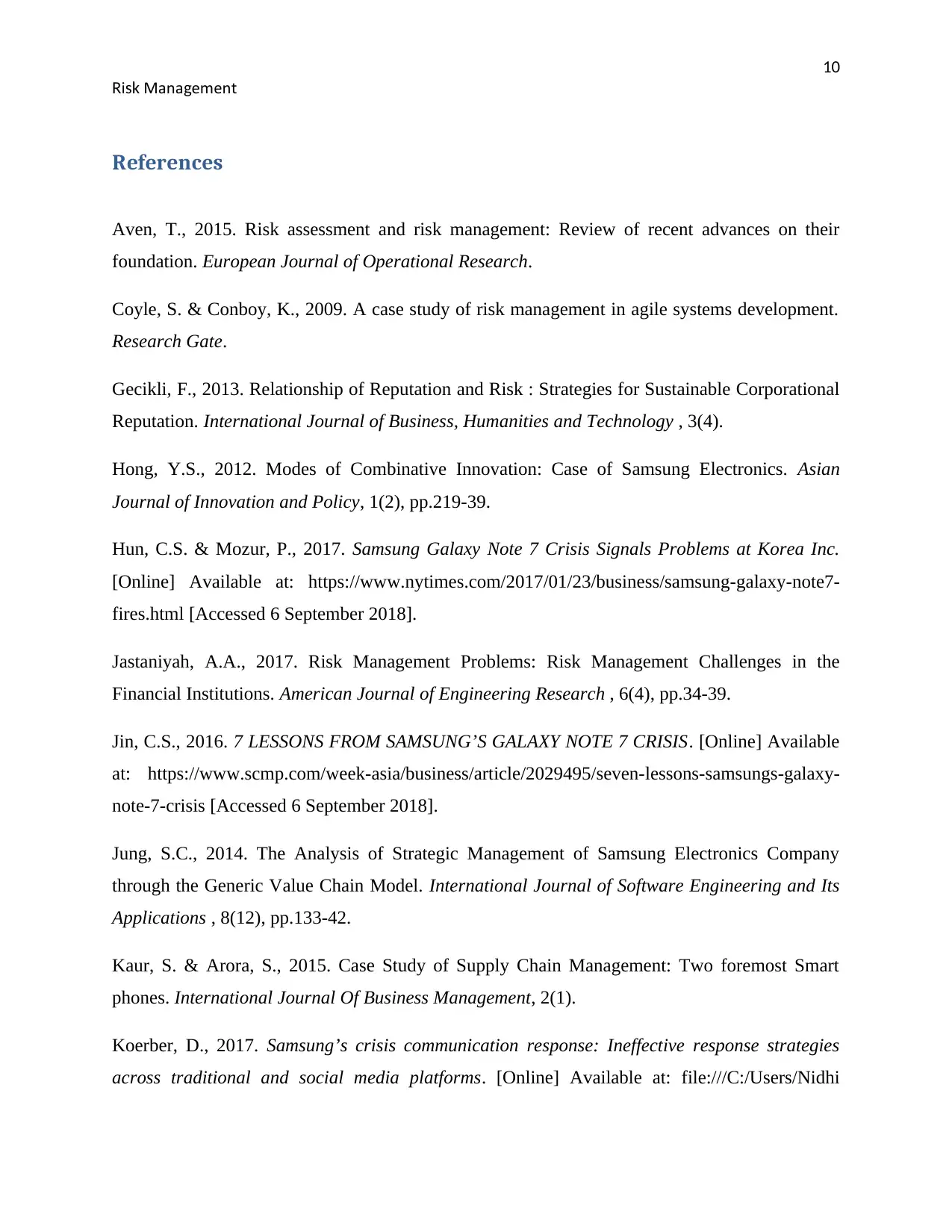
10
i Mana ementR sk g
References
Aven, T., 2015. Risk assessment and risk management: Review of recent advances on their
foundation. European Journal of Operational Research.
Coyle, S. & Conboy, K., 2009. A case study of risk management in agile systems development.
Research Gate.
Gecikli, F., 2013. Relationship of Reputation and Risk : Strategies for Sustainable Corporational
Reputation. International Journal of Business, Humanities and Technology , 3(4).
Hong, Y.S., 2012. Modes of Combinative Innovation: Case of Samsung Electronics. Asian
Journal of Innovation and Policy, 1(2), pp.219-39.
Hun, C.S. & Mozur, P., 2017. Samsung Galaxy Note 7 Crisis Signals Problems at Korea Inc.
[Online] Available at: https://www.nytimes.com/2017/01/23/business/samsung-galaxy-note7-
fires.html [Accessed 6 September 2018].
Jastaniyah, A.A., 2017. Risk Management Problems: Risk Management Challenges in the
Financial Institutions. American Journal of Engineering Research , 6(4), pp.34-39.
Jin, C.S., 2016. 7 LESSONS FROM SAMSUNG’S GALAXY NOTE 7 CRISIS. [Online] Available
at: https://www.scmp.com/week-asia/business/article/2029495/seven-lessons-samsungs-galaxy-
note-7-crisis [Accessed 6 September 2018].
Jung, S.C., 2014. The Analysis of Strategic Management of Samsung Electronics Company
through the Generic Value Chain Model. International Journal of Software Engineering and Its
Applications , 8(12), pp.133-42.
Kaur, S. & Arora, S., 2015. Case Study of Supply Chain Management: Two foremost Smart
phones. International Journal Of Business Management, 2(1).
Koerber, D., 2017. Samsung’s crisis communication response: Ineffective response strategies
across traditional and social media platforms. [Online] Available at: file:///C:/Users/Nidhi
i Mana ementR sk g
References
Aven, T., 2015. Risk assessment and risk management: Review of recent advances on their
foundation. European Journal of Operational Research.
Coyle, S. & Conboy, K., 2009. A case study of risk management in agile systems development.
Research Gate.
Gecikli, F., 2013. Relationship of Reputation and Risk : Strategies for Sustainable Corporational
Reputation. International Journal of Business, Humanities and Technology , 3(4).
Hong, Y.S., 2012. Modes of Combinative Innovation: Case of Samsung Electronics. Asian
Journal of Innovation and Policy, 1(2), pp.219-39.
Hun, C.S. & Mozur, P., 2017. Samsung Galaxy Note 7 Crisis Signals Problems at Korea Inc.
[Online] Available at: https://www.nytimes.com/2017/01/23/business/samsung-galaxy-note7-
fires.html [Accessed 6 September 2018].
Jastaniyah, A.A., 2017. Risk Management Problems: Risk Management Challenges in the
Financial Institutions. American Journal of Engineering Research , 6(4), pp.34-39.
Jin, C.S., 2016. 7 LESSONS FROM SAMSUNG’S GALAXY NOTE 7 CRISIS. [Online] Available
at: https://www.scmp.com/week-asia/business/article/2029495/seven-lessons-samsungs-galaxy-
note-7-crisis [Accessed 6 September 2018].
Jung, S.C., 2014. The Analysis of Strategic Management of Samsung Electronics Company
through the Generic Value Chain Model. International Journal of Software Engineering and Its
Applications , 8(12), pp.133-42.
Kaur, S. & Arora, S., 2015. Case Study of Supply Chain Management: Two foremost Smart
phones. International Journal Of Business Management, 2(1).
Koerber, D., 2017. Samsung’s crisis communication response: Ineffective response strategies
across traditional and social media platforms. [Online] Available at: file:///C:/Users/Nidhi
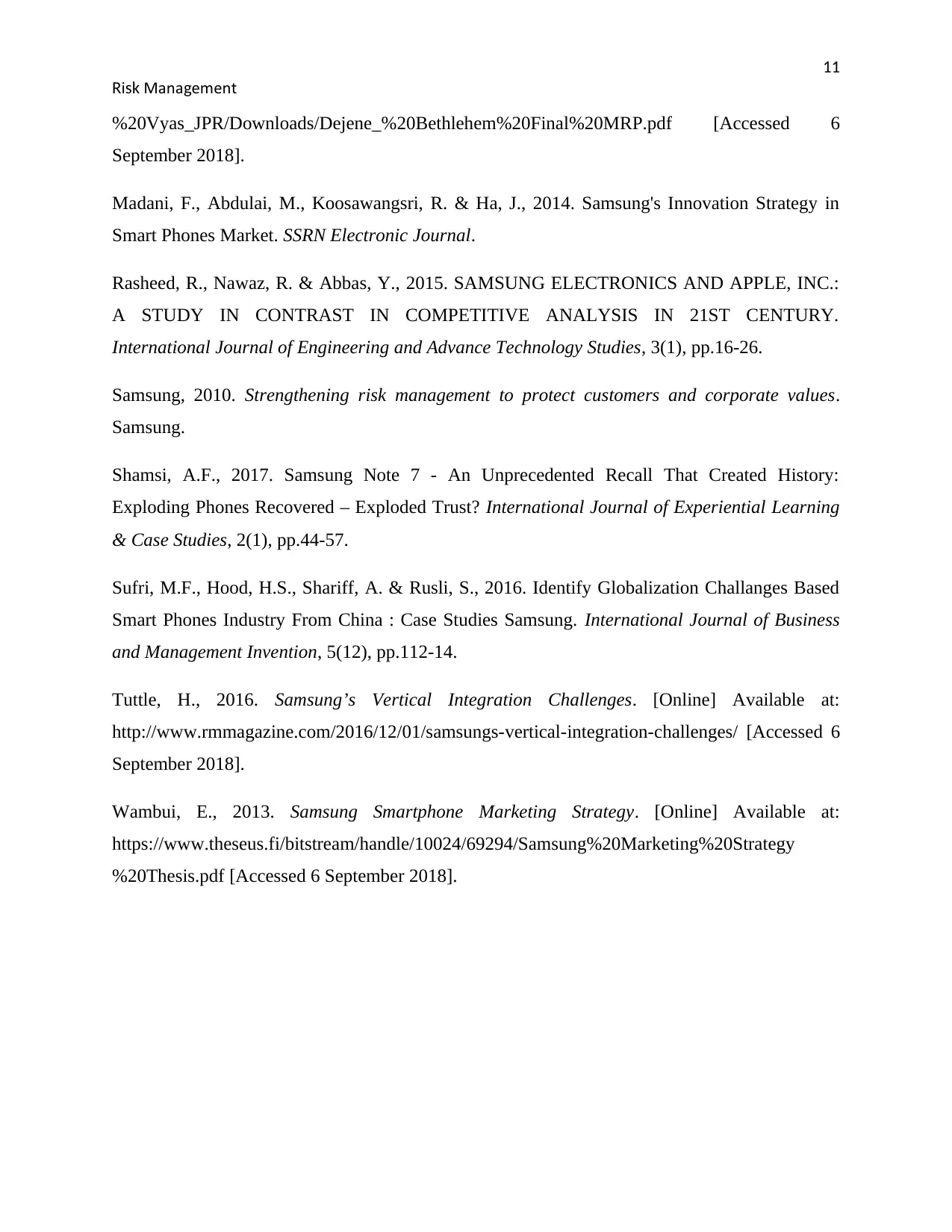
11
i Mana ementR sk g
%20Vyas_JPR/Downloads/Dejene_%20Bethlehem%20Final%20MRP.pdf [Accessed 6
September 2018].
Madani, F., Abdulai, M., Koosawangsri, R. & Ha, J., 2014. Samsung's Innovation Strategy in
Smart Phones Market. SSRN Electronic Journal.
Rasheed, R., Nawaz, R. & Abbas, Y., 2015. SAMSUNG ELECTRONICS AND APPLE, INC.:
A STUDY IN CONTRAST IN COMPETITIVE ANALYSIS IN 21ST CENTURY.
International Journal of Engineering and Advance Technology Studies, 3(1), pp.16-26.
Samsung, 2010. Strengthening risk management to protect customers and corporate values.
Samsung.
Shamsi, A.F., 2017. Samsung Note 7 - An Unprecedented Recall That Created History:
Exploding Phones Recovered – Exploded Trust? International Journal of Experiential Learning
& Case Studies, 2(1), pp.44-57.
Sufri, M.F., Hood, H.S., Shariff, A. & Rusli, S., 2016. Identify Globalization Challanges Based
Smart Phones Industry From China : Case Studies Samsung. International Journal of Business
and Management Invention, 5(12), pp.112-14.
Tuttle, H., 2016. Samsung’s Vertical Integration Challenges. [Online] Available at:
http://www.rmmagazine.com/2016/12/01/samsungs-vertical-integration-challenges/ [Accessed 6
September 2018].
Wambui, E., 2013. Samsung Smartphone Marketing Strategy. [Online] Available at:
https://www.theseus.fi/bitstream/handle/10024/69294/Samsung%20Marketing%20Strategy
%20Thesis.pdf [Accessed 6 September 2018].
i Mana ementR sk g
%20Vyas_JPR/Downloads/Dejene_%20Bethlehem%20Final%20MRP.pdf [Accessed 6
September 2018].
Madani, F., Abdulai, M., Koosawangsri, R. & Ha, J., 2014. Samsung's Innovation Strategy in
Smart Phones Market. SSRN Electronic Journal.
Rasheed, R., Nawaz, R. & Abbas, Y., 2015. SAMSUNG ELECTRONICS AND APPLE, INC.:
A STUDY IN CONTRAST IN COMPETITIVE ANALYSIS IN 21ST CENTURY.
International Journal of Engineering and Advance Technology Studies, 3(1), pp.16-26.
Samsung, 2010. Strengthening risk management to protect customers and corporate values.
Samsung.
Shamsi, A.F., 2017. Samsung Note 7 - An Unprecedented Recall That Created History:
Exploding Phones Recovered – Exploded Trust? International Journal of Experiential Learning
& Case Studies, 2(1), pp.44-57.
Sufri, M.F., Hood, H.S., Shariff, A. & Rusli, S., 2016. Identify Globalization Challanges Based
Smart Phones Industry From China : Case Studies Samsung. International Journal of Business
and Management Invention, 5(12), pp.112-14.
Tuttle, H., 2016. Samsung’s Vertical Integration Challenges. [Online] Available at:
http://www.rmmagazine.com/2016/12/01/samsungs-vertical-integration-challenges/ [Accessed 6
September 2018].
Wambui, E., 2013. Samsung Smartphone Marketing Strategy. [Online] Available at:
https://www.theseus.fi/bitstream/handle/10024/69294/Samsung%20Marketing%20Strategy
%20Thesis.pdf [Accessed 6 September 2018].
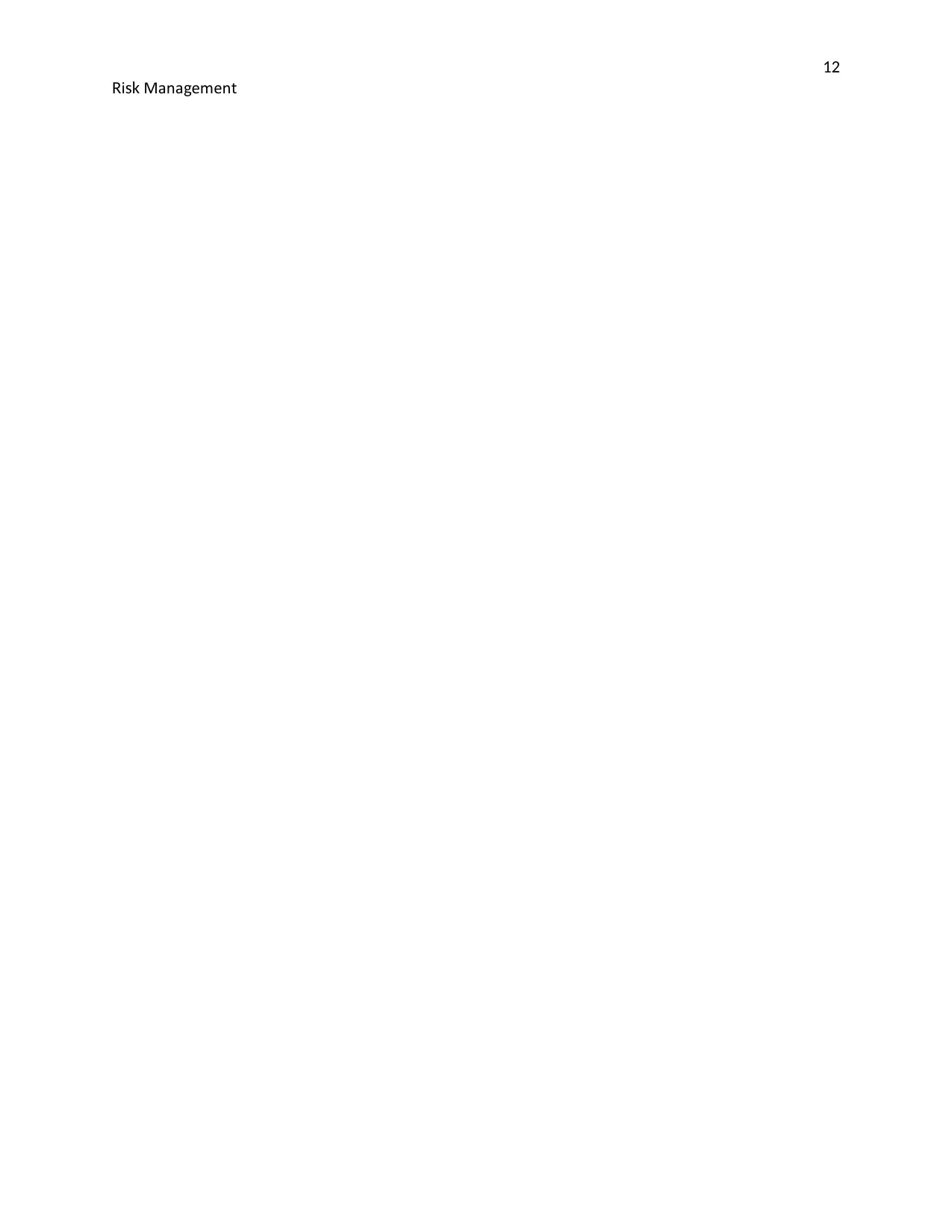
12
i Mana ementR sk g
i Mana ementR sk g
1 out of 13
![[object Object]](/_next/static/media/star-bottom.7253800d.svg)





